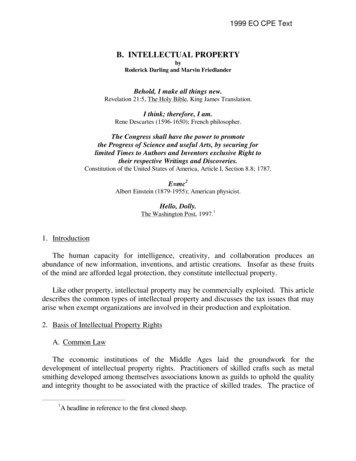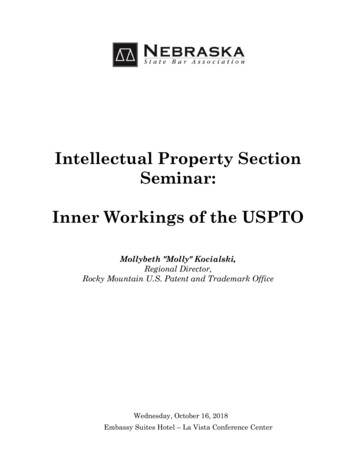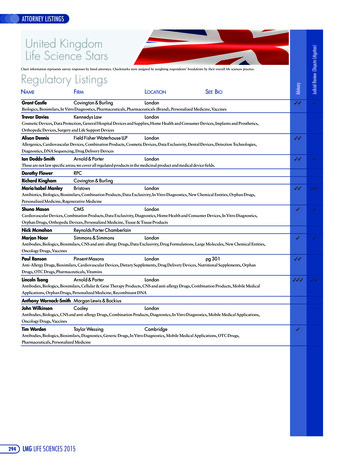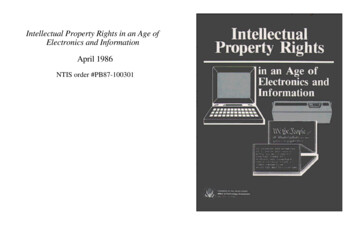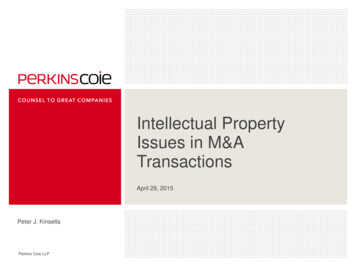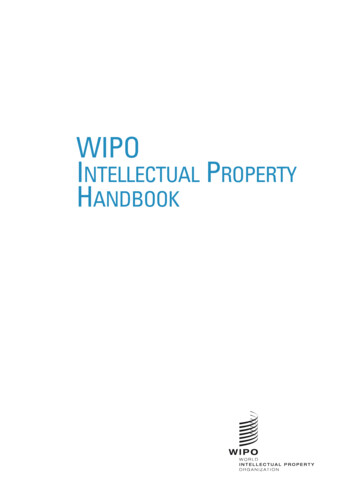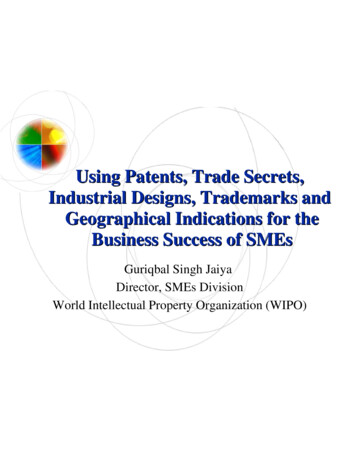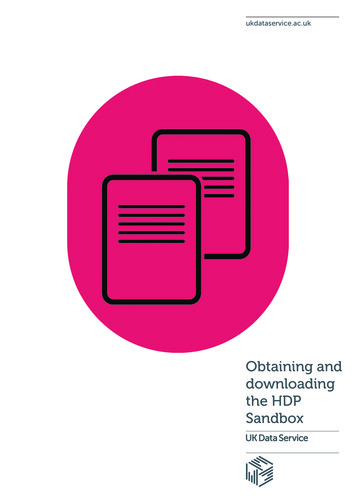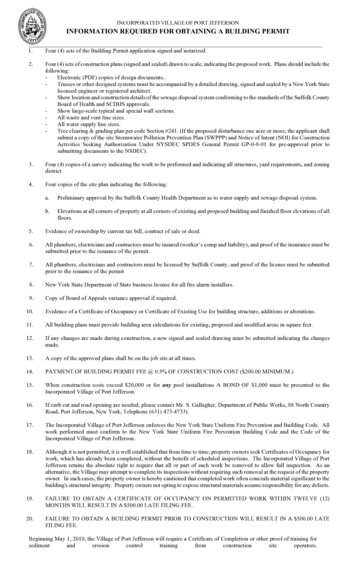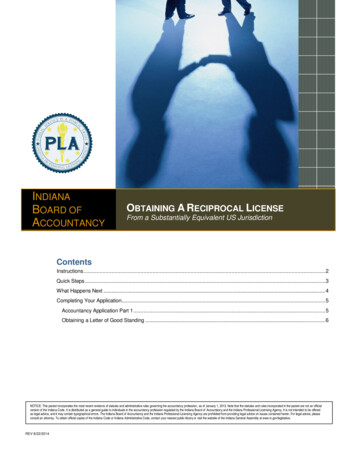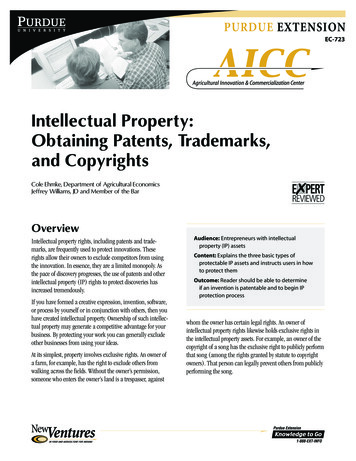
Transcription
PURDUE EXTENSIONEC-723Intellectual Property:Obtaining Patents, Trademarks,and CopyrightsCole Ehmke, Department of Agricultural EconomicsJeffrey Williams, JD and Member of the BarOverviewIntellectual property rights, including patents and trademarks, are frequently used to protect innovations. Theserights allow their owners to exclude competitors from usingthe innovation. In essence, they are a limited monopoly. Asthe pace of discovery progresses, the use of patents and otherintellectual property (IP) rights to protect discoveries hasincreased tremendously.If you have formed a creative expression, invention, software,or process by yourself or in conjunction with others, then youhave created intellectual property. Ownership of such intellectual property may generate a competitive advantage for yourbusiness. By protecting your work you can generally excludeother businesses from using your ideas.At its simplest, property involves exclusive rights. An owner ofa farm, for example, has the right to exclude others fromwalking across the fields. Without the owner’s permission,someone who enters the owner’s land is a trespasser, againstAudience: Entrepreneurs with intellectualproperty (IP) assetsContent: Explains the three basic types ofprotectable IP assets and instructs users in howto protect themOutcome: Reader should be able to determineif an invention is patentable and to begin IPprotection processwhom the owner has certain legal rights. An owner ofintellectual property rights likewise holds exclusive rights inthe intellectual property assets. For example, an owner of thecopyright of a song has the exclusive right to publicly performthat song (among the rights granted by statute to copyrightowners). That person can legally prevent others from publiclyperforming the song.
This publication describes the four general types of intellectual property protection (Table 1) and explains how to obtainprotection.Table 1. Four Types of IP ProtectionPatentProtects an original device, process, or composition of matterCopyrightProtects creative expressions and printed materials, e.g.,consulting manuals, books, maps, or computer softwareRegistered TrademarkGuards a product name, logo, symbol, or figureService MarkGuards a brand or service name, logo, symbol, or figurePatents can only be obtained in the United States through anapplication to the federal government. Copyrights, trademarks, and service marks may be obtained through tangibleexpression and/or use, but federal registration of these IPtypes provides additional protections. Once obtained, intellectual property is like any other property; it can be sold,licensed, given away, or even forfeited. If you are usingintellectual property that belongs to others, then you shouldbuy it or acquire the rights to use it through a license in orderto avoid a dispute and expensive litigation.PatentsA patent is the grant of a property right issued to the inventorby the United States Patent and Trademark Office (USPTO).The federal government grants the inventor exclusive rights toprofits in his or her invention upon the issuance of a patentclaiming the invention. The duration of a patent is up to 20years from the filing date of the patent application, althoughonly limited rights to sue infringers are available between thetime the application is filed and when the respective patentissues (i.e., the “Patent Pending” period). After the patent isissued, and before it expires, the patent is the holder’s personalproperty and can be sold, given away, or licensed to anyonethe patent holder chooses. Upon expiration of the patent, thepatent becomes a part of the public domain.There are three types of patents. A utility patent is for aprocess, machine, article of manufacture, composition ofmatter, or any new and useful improvement thereof. A design2patent is for the ornamental design for an article ofmanufacture. A plant patent is for inventing or discoveringand asexually reproducing any distinct and new variety ofplant. Utility and plant patents are granted for up to 20 yearsfrom the date of application filing. Design patents are for 14years from the date the patent issues from an application.What Is Patentable?A patent can be issued if you invent any new useful process,machine, process of manufacture, or composition of matter.(Essentially these are, respectively, industrial/technicalprocesses; machines; making things and the things that aremade; and chemical compositions, mixtures of ingredients,and new compounds.) In addition, an improvement to aninvention can sometimes be patented. Even a small functional or decorative improvement may be patentable. Soeven if you did not invent the mousetrap, you could certainlypatent an improved one.An idea is patentable if it meets three criteria: novelty,usefulness, and nonobviousness.1. Novelty: Nothing essentially the same as the claimedinnovation exists; i.e., the invention must be new. It isimportant to note that if the public were aware of orused the invention in this country, or if the inventionwas sold, offered for sale, or used commercially (evenif hidden from public view, such as a secret machineon an assembly line) more than one year before theapplication date, then the invention would not benovel, and the application would be denied.2. Usefulness: The invention must provide significantbenefits to society, although this requirement isgenerally more relaxed than it sounds.3. Nonobviousness: The invention must possess a newcharacteristic that is not known in the field and mustnot be obvious to a person with an average or ordinaryknowledge of the field at the time the application isfiled.The ultimate decision on whether or not your invention ispatentable is made by USPTO, when it examines yourapplication. But there are some steps you can take to pave theway for a favorable outcome. The questions in the “PatentQuestions” section will help you determine if your idea ispatentable. However, the best way to establish the novelty of anPurdue Extension Knowledge to Go
invention is to conduct a search of the Patent Office files andworldwide publications. To assist you in your search process,the federal government created the Depositing LibraryProgram. Libraries in this program contain issued patentsand provide technical staff and useful publications. You canfind library locations through the Government Printing Office(URL at the end of this publication).InfringementAnyone who makes, uses, sells, or imports a patented productwithout the patent holder’s consent has committed infringement. With any unauthorized use, the patent holder can bringa civil suit for damages against the infringer. If the suit issuccessful, a patent holder may receive either (1) lost profitsthat were taken by the infringer or (2) reasonable royalties,depending on a number of factors.If the infringement is determined to be willfull, then damagesof up to three times the actual damages, as well as court costsand attorneys fees, may be awarded. To win on the issue ofinfringement, the patent holder must show that he or sheowns the patent and that the defendant infringed on thepatent. The infringer may try to win the suit by proving thepatent was invalid (e.g., that the invention was not novel ornonobvious) or unenforceable (e.g., due to inequitableconduct by the patentee).Obtaining PatentsBefore beginning the patent application process, an inventorshould know as much about what has already been invented(the “prior art”) as possible. The application to the PatentOffice must show how the invention works, typically includingdetailed technical drawings and written information describing how the device can be used (and for some types ofinventions, manufactured). Utility patent applications alsoend with a set of claims that serve as the legal definition ofwhat is sought to be patented. As part of the application, theinventor must pay an application fee and may have to pay aseparate examination fee. If the application issues a patent,the inventor (or other owner of the patent) is required to paya periodic maintenance fee, usually due every few years.3A U.S. patent application requires: A declaration that the applicant discovered the invention(by him- or herself or with other co-inventors); A detailed specification, including necessary drawingsto explain the invention, and a written descriptionwith claims. The elements of the specification shouldenable an informed person in the field to make anduse the invention; and The required fees.A patent examiner will review the application and decide ifthe application is allowable. This will typically involve areview of issued patents, publications, and materials suppliedby the applicant under a duty of disclosure to ensure that theinvention has not already been protected, was not known byothers prior to being conceived by the applicant, or was notpublicly disclosed, used, sold, or offered for sale more thanone year before the applicant filed his or her patent application.The application process for a utility patent typically costs atleast a few thousand dollars and sometimes 10,000 or more,including the fees of a patent attorney or agent. The application process typically takes from one to three years, but maytake longer. If the claims of the application are rejected(usually because the examiner found prior patents), then theinventor may respond to the examiner’s rejection. If a finalrejection is then levied, the applicant may appeal to theUSPTO Board of Patent Appeals and Interferences, and theneither to the U.S. Court of Appeals for the Federal Circuit orthe U.S. District Court for the District of Columbia. Manypatent applications are filed that never yield an issued patent.The application process requires a thorough knowledge ofthe technical aspects of the patent as well as of the patentprocess. In some cases, the inventor may be able to acquireintellectual property rights by him- or herself. But the processis tedious and lengthy, so it is often advisable to use aregistered attorney or patent agent. Additionally, an improperly drafted application could fail to specifically define theinnovation or define it so broadly as to be useless. Theultimate goal is to obtain a patent with claims sufficientlybroad as to prevent others from legally copying your invention.Purdue Extension Knowledge to Go
If the USPTO improperly issues you a patent with claims thatcover the prior art, then someone accused of infringing it willhave a strong defense. By using a professional advisor, youwill maximize your chances of obtaining a patent witha meaningful scope of protection.must have labels on the seed containers indicating the type ofprotection. Additionally, farmers may save a limited amountof the plant variety seed for replanting, but cannot sell it toanyone without permission of the owner of the PVPA rights tothe variety.Patent QuestionsA Certificate of Protection is awarded to a variety’s owner afteran examination shows that it is new, distinct from othervarieties, and genetically uniform and stable throughsuccessive generations. The cost of protection is 4,084.Owners of U.S. protected varieties have exclusive rights tomultiply and market the seed of that variety. Protection is for 20years for most crops and 25 years for trees, shrubs, and vines.Answer the following questions regarding your idea to helpyou determine if your idea is patentable.1. Is the invention of practical use?2. Does the invention show an element of novelty (somenew characteristic not know in its technical field)?3. Would someone skilled in the field be unable todeduce the invention in view of what is alreadyknown? Note: If there is no suggestion or motivationin the field to combine or modify past knowledge tocome up with your invention, even if it is physicallypossible to pick and choose known features in the artto form your invention, then your invention wouldnot be considered “obvious” in light of the prior artand may be patentable.4. Was the invention described in a printed publicationanywhere or used in this country more than one yearprior to the date of patent?5. Was the invention in public use or on sale in thiscountry more than one year prior to the date of thepatent?Trademarks andService MarksTrademarks are a way that businesses can identify goods astheir own. Trademarks can be words, names, symbols, ordevices that are used in trade with goods to indicate the sourceof the goods and to distinguish them from the goods of others.A service mark is the same as a trademark except that itidentifies and distinguishes the source of a service rather thana product. The terms “trademark” and “mark” are commonly used to refer to both trademarks and service marks.Obtaining TrademarksPlant Variety Protection Act (PVPA)Trademarks (and service marks) are essentially acquired intwo ways (aside from purchasing rights in a mark from arightful owner). First, acquisition may be accomplishedthrough use of the mark in commerce. Acquiring a trademarkthrough use alone limits the mark owner to protection of themark in the geographic area in which it is used. If the mark isused in conjunction with goods or services offered over theInternet, however, the mark owner may, in some circumstances,enjoy exclusive rights to use the mark nationwide.Providing protections similar to the federal patent laws, thePlant Variety Protection Act of 1994 grants developers of newvarieties of plants a certificate with patent-like rights thatprotect the reproduction and distribution of such varieties.The PVPA ensures that protected varieties can be sold as seedstocks only if permission of the certificate holder has beenobtained and, in some cases, only as a class of certified seed.To take advantage of the protections under the PVPA, varietiesSecond, federal law (as well as individual state laws) allowsapplicants to reserve, or “register,” a trademark. Trade orservice marks cannot be for names, titles, or certaincategories of similar phrases and cannot be generic terms.For instance, a trademark like Coca-Cola identifies anddistinguishes a product, but the term “cola” is too generalto trademark. A trademark cannot be the same or confusinglysimilar to a trademark already in use. A search of the federalIf you can answer “yes” to the first two questions and “no” tothe last three, then your idea may be patentable. If it is, andyour idea holds commercial promise, then you should beginthe patent application process.4Purdue Extension Knowledge to Go
registrations—and preferably state registrations and otherdatabases containing brand names for goods and services,including Internet domain names—will be necessary todetermine this. You can find the URL for the USPTO at theend of this publication. Registration requires that thetrademark be in use on goods sold as part of business. If thegoods are sold in only one state, then that state’s trademarklaw will apply. If sold as part of interstate commerce, thenfederal law will apply.CopyrightA typical registration fee is 335 per class of good and/orservice sold in conjunction with the mark. Protection lasts for10 years before it must be renewed, but filings attesting to useof the mark must be made at 8 and 15 years after the mark isregistered. Fees for renewal and penalties for late renewalapply.Formal registration with the Copyright Office creates a publicrecord of the copyright and, in most cases, serves as absoluteevidence of the copyright’s validity and entitles statutorydamages of up to 100,000 per infringement to be available tothe copyright owner (who is otherwise limited to actualdamages and lost profits). The registration fee is 30. A searchof the Copyright Office records may help you identify registered copyrights (URL at the end of this publication).If an application for a trademark or service mark is rejected itis probably because:1. There is a likelihood that consumers will confuse yourmark with a mark already registered or applied for oran unregistered well-known mark;2. Your mark merely describes a product, service, orfeature of the product or service;3. Your mark consists of a geographical term that ismisleading or should not be monopolized by a singleenterprise; or4. Your mark violates public order or morality.The standard format of notification of a trademark is to placethe letters “TM” after every use of the trademark or symbol.Use “SM” for a service mark. You should use the symbol when the federal trademark registration process has beencompleted and confirmed.5Obtaining copyright does not require an official registration. Acreated work is considered protected by copyright as soon as itexists. If the work has been put into a fixed form, such aswritten down or recorded, then it is considered copyrighted.While registration is not necessary, filing with the U.S.Copyright Office of the Library of Congress adds protection inthe event of a dispute.Generally, for works created after 1978, copyright protectionlasts for the author’s life plus 70 years. In the case of worksmade for hire (a technical definition that does not necessarilyinclude independent contractors), the protection is for 95years from publication or 120 years from creation, whicheveris shorter.Once a work has been copyrighted (i.e., created and fixed in atangible medium of expression) the author can notify users ofthis by using a copyright notice, such as the symbol or theword “Copyright.” These symbols should be used in conjunctionwith the year of creation and the name of the copyright owner.Final CommentAnother type of IP right you should be aware of is trade secretprotection. Although this publication did not cover rights intrade secrets, you should know that trade secret laws (bothfederal and state laws) protect the owner of confidentialinformation when such information puts the owner at acompetitive advantage in the relevant market.Purdue Extension Knowledge to Go
ResourcesFor more information about patents and trademarks, consult the following sources.Online searchable database for patent, trademark, and service mark queries:U.S. Patent and Trademark Officewww.uspto.govU.S. Copyright Officewww.copyright.govU.S. Government Printing Officewww.gpoaccess.govSearchable database, publications, and other online resources:Plant Variety Protection A, Inc. (Bureau of National Affairs) IP Center Onlineipcenter.bna.comIntellectual property research and publications:Cornell University's Legal Information Institute (provides the U.S. Code)www4.law.cornell.edu/uscodeU.S. Copyright Office's Entrepreneur's Reference Guide to Small Business egorized compilation of books, references, and directories on general entrepreneurship:World Intellectual Property Organizationwww.wipo.int/index.htmlInformation on international intellectual property issues:The Entrepreneur's Guide to Business Law, by Constance Bagley and Craig Dauchy (1998).Visit Us on the WebAgricultural Innovation and Commercialization Centerwww.agecon.purdue.edu/plannerNew Ventures Teamwww.agecon.purdue.edu/newventuresPurdue Partners for Innovation in Indiana AgricultureAgricultural Innovation & Commercialization CenterNew Ventures TeamCenter for Food & Agricultural BusinessPURDUE AGRICULTURE10/04It is the policy of the Purdue University Cooperative Extension Service, David C. Petritz, Director, that all persons shall have equal opportunity and accessto the programs and facilities without regard to race, color, sex, religion, national origin, age, marital status, parental status, sexual orientation,or disability. Purdue University is an Affirmative Action institution. This material may be available in alternative w6Purdue Extension Knowledge to Go
owns the patent and that the defendant infringed on the patent. The infringer may try to win the suit by proving the patent was invalid (e.g., that the invention was not novel or nonobvious) or unenforceable (e.g., due to inequitable conduct by the patentee). Obtaining Patents Before beginning the

